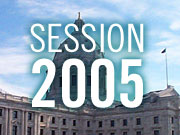January 6, 2005
 |
| A specialist with the Neighborhood Health Care Network answers questions from Minnesota residents struggling with obtaining health care. (MPR Photo/Laura McCallum) |
St. Paul, Minn. — Two years ago, Gov. Pawlenty called health care spending the public policy sumo wrestler in the room. In an attempt to tackle the problem, the Legislature scaled back eligibility and benefits, and increased premiums for public health care programs. But the sumo wrestler appears to be heavier than ever. Pawlenty says health and human services spending threatens to devour the state budget; if left unchecked, it will comprise 85 percent of the state budget within 12 years.
"It is unsustainable, it is broken and it cannot stand in its current form," he says.
Pawlenty says the budget he proposes later this month will slow down the projected growth in state health care programs from 27 percent over two years to 20 percent. Speaking to reporters last month, Pawlenty offered some clues about where he's likely to recommend cuts.
"If you're not a senior, if you're not disabled, if you don't have children, in other words, you're an able-bodied, single adult who can otherwise perhaps find an opportunity in the marketplace. Those are the kinds of people we're going to look at and say, are our benefits out of line?" Pawlenty said.
Pawlenty's last budget recommended eliminating General Assistance Medical Care -- or GAMC -- a state program that provides health insurance to very low-income adults without children. To qualify for the program, you must earn less than about $600 a month.
Pawlenty wanted to roll people on that program into MinnesotaCare, the state's subsidized health insurance program. Unlike GAMC or Medical Assistance, people in MinnesotaCare pay monthly premiums.
Senate DFLers wouldn't agree to eliminate GAMC. Pawlenty may renew his push to eliminate the program, particularly since spending on GAMC is projected to go up more than 37 percent from one two-year budget cycle to the next.
Sen. Linda Berglin, DFL-Minneapolis, who chairs the Senate Health and Human Services Budget Division, argued against cutting health care programs two years ago. She says she'll do the same this year.
"Simply cutting more people out of the system of getting affordable health care is not going to solve the problem. It's going to make the problem worse."
Berglin says the state's health care costs are going up for a couple of reasons. A higher unemployment rate means there are more low-income people who turn to the state for health insurance. And people are losing health coverage in the private sector. That's evident at Neighborhood Health Care Network, a non-profit that runs a help line for people seeking health care.
"Good afternoon, 489-Care, this is Valerie ... You said you don't have any insurance at this time - are you working?"
This particular caller is working, but can't afford health insurance. Calls to the help line are up 50 percent from the previous year.
The executive director of Neighborhood Health Care Network, Lisa Edstrom, says many of the low-income people the network helps are working two or even three jobs.
"Some people working in nursing homes, people working in churches, people working for nonprofit organizations, restaurants that do not have good benefit programs, and certainly do not offer benefits to part-time employees," according to Edstrom.
Edstrom worries that any cuts in state health care programs will simply shift costs from the state to clinics and hospitals.
State Human Services Commissioner Kevin Goodno doesn't dispute that cuts in certain programs can cause some cost-shifting. But he points to something he calls the "woodwork effect." Goodno says when Minnesota has expanded state programs, people have shown up to use them.
"To the extent that we're restricting the growth in programs or cutting back on programs, I think there's going to be a combination. There may be people that may end up in more costly alternatives, but there will be other people that will go back to being supported by their community, by their friends, by their family," Goodno said.
At the same time lawmakers are debating cutting health care programs, there is actually a surplus in the fund that pays for MinnesotaCare. Republican leaders will argue for using that projected $226 million surplus in the health care access fund to help balance the overall state budget.
DFL leaders say the money should be used to restore some of the MinnesotaCare cuts from two years ago.







